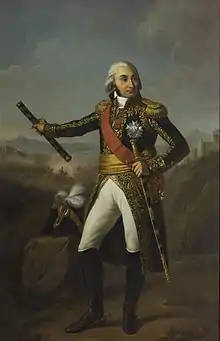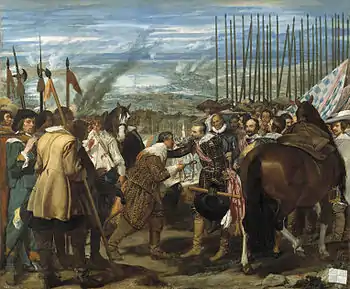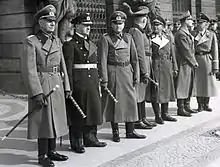Baton (military)
The ceremonial baton is a short, thick stick-like object, typically in wood or metal, that is traditionally the sign of a field marshal or a similar high-ranking military officer, and carried as a piece of their uniform. The baton is distinguished from the swagger stick in being thicker and effectively without any practical function. A staff of office is rested on the ground; a baton is not. Unlike a royal sceptre that is crowned on one end with an eagle or globe, a baton is typically flat-ended.


Ancient world
The origin of the military baton is unclear. In western Europe, batons served a similar purpose as the Roman fasces lictoriae: a symbol of power and authority. A short, heavy, white baton was the symbol of the imperial mandate given to a Roman military legate. He held it high proclaiming "above your head and mine" to represent the emperor.
It is possible that the Spartan cipher rod, scytale, also had a related military status, pre-dating the Roman baton, but the first detailed reference in Plutarch dates from the Roman period.
Middle ages to early modern period

Batons were given to top commanders in most European armies from at least the Renaissance, as a revival of classical practice. They were typically presented by the monarch, and latterly were often elaborate pieces of metalwork, though earlier portraits show plain batons of wood, often longer and thinner than later examples. They were also typically carried by monarchs when portrayed in military dress. The French kings, and Napoleon, provided Marshals of France with ornate batons, typically of blue velvet with metal fleurs-de-lys before the French Revolution, then stars or Napoleonic eagles.
The Duke of Wellington possessed multiple batons, since he held the rank of field marshal or equivalent in eight European armies each of which presented him with a baton. In addition to his English baton he was presented with two British batons.[2] Nine of the batons (along with some staffs of office) are displayed at his former home, Apsley House (the Russian baton was stolen on 9 December 1965 and has not been recovered).[1][3][4]
Tsar Alexander I presented five batons, one to the Duke of Wellington and four to Russian generals.
The first [Russian] Field Marshal's baton, the emblem of this high military rank, was given to Count Fedor Golovin in 1700. In the 19th century, during the reign of Alexander I (1801-1825), only four Russian Generals and the Duke of Wellington received the coveted baton. Six were awarded during the reign of Nicholas I (1825-1855), and a further six were issued under Alexander II (1855-1881). No Field Marshals were appointed during the reign of Alexander III (1881-1894) and only four batons were awarded during the reign of Nicholas II (1894-1917), the last being to His Royal Highness King Karl I of Rumania in 1912.
Crossed batons may appear as the distinctive uniform rank insignia on (epaulettes or shoulder boards) of field marshals. The Third Reich-era Generalfeldmarschall's insignia is an example of this, as is that of the Field Marshal of the United Kingdom. In any event, while doing their routine work, modern-day field marshals often carry simpler batons, keeping more elaborate ones for ceremonial occasions.
Nazi Germany

In Nazi Germany, Generalfeldmarschalls and Großadmirals carried ceremonial batons, specially manufactured by German jewellers. Seven styles of batons were awarded to 25 individuals. Hermann Göring earned two different-style batons for his Generalfeldmarschall and Reichsmarschall promotions.
All the batons, except Erich Raeder's, were designed in a similar way: a shaft decorated with Iron Crosses and Wehrmacht eagles. Luftwaffe (air force) shafts showed the Balkenkreuz ("beam cross"), whereas Kriegsmarine (navy) shafts had fouled anchors. The ends of the batons were decorated with ornate caps.
- The seven styles of Nazi-era batons
- The first baton awarded was to Field Marshal Werner von Blomberg. This baton's shaft had a light blue velvet covering material. It is now in the National Museum of American History in Washington, DC.
- The first air force baton awarded was to Hermann Göring after his promotion to field marshal. Though it was designed similarly to the Blomberg baton with a light blue velvet shaft covering, it incorporated the air force Balkenkreuz symbols. Additionally, the end caps were inlaid with many small diamonds. It is now kept in the National Infantry Museum at Fort Benning, Georgia.
- The next baton awarded was to Grand Admiral Erich Raeder. This baton's shaft had a dark blue velvet covering. This baton differed from other batons by having a chain link pattern sewn over the crosses, eagles and anchors. At the end of the war, the baton was reportedly disassembled and sold in pieces.
- Nine army batons were awarded in the summer of 1940 to newly promoted field marshals. The batons' shafts had red velvet coverings and differed only in identifying inscriptions on the end caps. Eight more batons of this style were later awarded to other field marshals upon their promotions. The first group was manufactured for 6,000 RM (about 30,000 USD in 2012) each. Most of the batons are now in museums or private collections.
- Three air force batons were awarded in the summer of 1940. They had blue velvet covering and the Balkenkreuz design, differing only in individual end cap inscriptions. One more baton of this style was awarded in 1943. The 1940 air force batons were slightly more expensive to manufacture than the 1940 army batons.
- The only other navy baton was awarded to Grand Admiral Karl Dönitz. It had a blue velvet shaft covering and incorporated a U-boat symbol on one of the end caps. It is now in the Shropshire Regimental Museum, Shrewsbury, UK, and was donated by Major General J. B. Churcher, who captured Dönitz at war's end and stole the baton.
- The only Reichsmarschall baton was presented to Hermann Göring in 1940. While similar looking to the other 1940 batons, it incorporated exceptional materials. The shaft was white elephant ivory, not velvet-covered metal. The end caps incorporated platinum in the inscription banding and over 600 small diamonds. The baton was manufactured for 22,750 RM (about 130,000 USD in 2012). It is now in the U.S. Army's West Point Museum, Highland Falls, New York.
In heraldry and culture
_Mar%C3%A9chal_de_France.svg.png.webp)
A baton appears occasionally in heraldry as an armorial achievement by field marshals upon achieving substantive or honorary rank. In England and Wales, batons are usually represented as behind the coat of arms crossed in saltire although the sole holder of this achievement in practice is the Duke of Norfolk in his capacity as Earl Marshal.
See also
References
- Howe, Malcolm (2000). "Wellington's Batons". British Historical Society of Portugal. 27: 13–22.
- "Batons [of] the Late Duke of Wellington". The Illustrated London News No. 532. 11 December 1852. Retrieved 8 June 2011.
- "Duke of Wellington's batons". English Heritage. Archived from the original on 15 March 2012. Retrieved 8 June 2011.
- Staff 1965, p. 2.